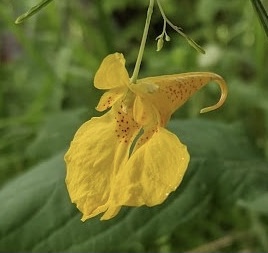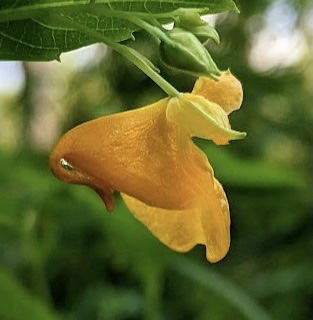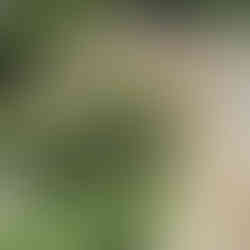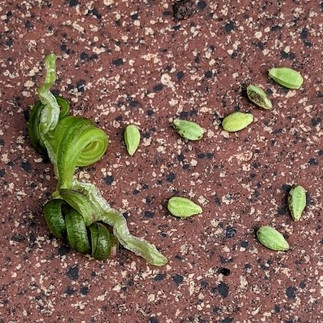Plant Profile: Jewelweeds – Jewels of the Later Summer
- Patsy Cotterill

- Apr 2, 2024
- 4 min read
Updated: Jun 20, 2024
Most people encounter the balsam family, Balsaminaceae, through busy lizzie, Impatiens walleriana, the common annual of municipal garden beds. However, we have three wild-growing Impatiens species in Alberta: the native Impatiens noli-tangere, I. capensis and the non-native I. glandulifera. All are tall (to 150 cm in the natives), often branched, annual herbs with succulent, somewhat translucent, reddish stems, simple, ovate-lanceolate to lanceolate, hairless, shallowly toothed leaves and large, attractive flowers. They are found in wet habitats such as moist woods, swamps and shady ravines.

Impatiens noli-tangere, western jewelweed or yellow touch-me-not (among other common names) seems somewhat more common locally than I. capensis, spotted jewelweed or orange touch-me-not. Its large (to 3 cm) yellow flowers are produced in July through September in the axils of the leaves on branched, filiform stalks that arise mostly below the leaves (although some are above them) and dangle horizontally like suspended slippers. Of the three sepals, two are small, white and paired, but one forms a yellow, funnel-like pouch or sac which ends in a narrow, recurved spur. The spur in particular is spotted with dark red or purple dots; it produces nectar attractive to hummingbirds, bees and a variety of other insects. The petals appear as two large lateral lobes forming a lip that functions as a landing pad for insects. A small upper petal forms a cap above the tight cluster of stamens surrounding a thin, green pistil which will become a narrow, green seed capsule or pod. This pod splits explosively when it is ripe, ejecting the seeds a considerable distance, sometimes to the surprise of an approaching visitor. This phenomenon is also the reason for the species’ Latin epithet, noli-tangere, which means “be unwilling to touch.” Many of the pods, however, are not produced by the large, showy yellow flowers (called chasmogamous) but by small, inconspicuous flowers that are fertilized without opening (called cleistogamous).
Impatiens capensis, spotted jewelweed, is very similar, and may sometimes be found growing with western jewelweed. The two are distinguished on flower colour and shape, and the angle of recurvature of the spur, as follows:
Impatiens noli-tangere: flowers pale yellow, red-dotted, occasionally unspotted; sac approximately 20 mm long, about half as broad as long (making for a more slender flower), with the spur curled under at a loose angle;
Impatiens capensis: flowers orange to reddish, spotted with red or purple; sac shorter (15-18 mm) and about two-thirds as broad as long (making for a shorter, chunkier flower), and a spur that is abruptly curled back (a bit like a pig’s curly tail).
Western jewelweed is a circumpolar species that occurs in western Canada (west of Ontario), and also in Europe and Asia. Spotted jewelweed is exclusively North American and is native across Canada, except for B.C. where it has been introduced.
Himalayan or Indian balsam, or purple jewelweed, Impatiens glandulifera, our third Albertan Impatiens, by contrast is a native of the Himalayan mountains, as its name suggests. It has been introduced into northern temperate countries for its beauty, and other qualities, with disastrous results. Its large flowers are pale to deep pink, 3-4 cm long, with a short spur and the upper petal now forming a hood such that the flower resembles a policeman’s helmet (the English name for the species). The deep-green, glossy, lanceolate leaves arise in groups of three at the nodes of the red, succulent stems. The specific name glandulifera derives from the nectar-producing glands at the base of the leaf stalks.
More restricted to riparian habitats than our native jewelweeds, Himalayan balsam creates dense stands along river shores in its adopted countries, replacing native perennial vegetation and leading to bank erosion when these shallow-rooted annuals die down in the fall. It has been introduced across most of Canada, but is rare in Alberta. It has occurred in Edmonton’s river valley and at Pigeon Lake. In Alberta it is a prohibited noxious weed under the Weed Control Act, illegal to buy, sell, transport or possess, as it is in the European Union. Stands can be readily removed by pulling, however, or by cutting off the flowers to prevent seed production. Interestingly, it is not listed as present in Moss’s Flora of Alberta published in 1983. (See en.wikipedia.org/wiki/Impatiens_glandulifera for an account of its fascinating history in Europe, and an illustration of ecological repercussions when Man meddles.)
So why are the jewelweeds called jewelweeds? Some literature suggests that it may be because the leaves are water-repellent and rainwater falling on their surface forms beads of water droplets (this is indeed the case) which shine in the sun. My own theory is that the delicate yellow flowers shine like jewels amid the deep glom of a summer swamp! They have even been mistaken for orchids!
An interesting afterthought: plants that have a wide distributional range often vary greatly in abundance across that range. The literature suggests that Impatiens noli-tangere may be scarce and/or under threat in Europe. Hence, is it possible that maintaining the species in Canadian habitats, where it is abundant, is a hedge against extinction of the species?






















